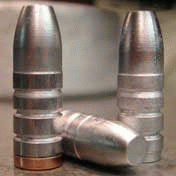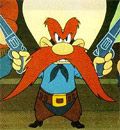

 The Accurate Reloading Forums
The Accurate Reloading Forums  THE ACCURATE RELOADING.COM FORUMS
THE ACCURATE RELOADING.COM FORUMS  Guns, Politics, Gunsmithing & Reloading
Guns, Politics, Gunsmithing & Reloading  Cast Bullets
Cast Bullets  Bumping cast bullets on larger size
Bumping cast bullets on larger sizeGo  | New  | Find  | Notify  | Tools  | Reply  |  |
| one of us |
I checked recently (started with this https://forums.accuratereloading.com/eve/forums/a/tpc/f/1811043/m/856101974 ) several un-sized cast bullets and found that good number of them have the driving band in front of crimp groove smaller than groove dia for that specific calibre. Examples: 41 are .407-.0408, 357 are 355-356, 44 are .426-.428, etc. The rest of bullet has enough large dia-s so it could be sized to fit the cylinders. I remembered article in “Handgunner†about Keith bullets mentioning the same problem. It was done on purpose to make bullets fit all revolvers, regardless of cylinder bores. Author Brian Pierce (if I remembered his name correctly) pointed this as almost certain cause of inaccuracy, and, according to what I found so far, everything points that he is right on. Now, the main issue with cast bullets is to fit hardness to the load so bullet will obturate properly; too hard, wouldn’t obturate/seal the bore under the pressure, too soft creates excessive leading. In that respect, straight wheel weight is just about right for velocities I am looking for; 1100-1200 fps so I can use plain base bullets, no gas check If the proper obturation is desired and expected, how about mechanical obturation by some kind of die that will press the bullet and make all diameters uniform. The die should be designed to have adjustable stop so all bullets will be compressed on same height. I found this locally available bullet for 40-65, see http://www.buffaloarms.com/browse.cfm/4,1547.htm , and looks as a good candidate to be bumped up to .411 dia, to be used in 41 Magnum revolver. Anybody done this? Thanks, Onty. | ||
|
Moderator |
I'm a lazy caster and try to keep the process as simply as possible. Hence my preference is to have the mold cast the dia I want, and if a mold casts small, I'll lap it to cast to the desired dia. I'm also of the feeling that cast bullets should be sized as little as possible, preferably not at all. Aircooled wheelweights should be soft enough to bump up, and still hard enough for your velocities if you want to try the bump route. __________________________________________________ The AR series of rounds, ridding the world of 7mm rem mags, one gun at a time. | |||
|
| one of us |
Onty, You're indeed correct about undersized driving bands on some revolver CB designs. As I write this, I have one Lyman #429360, designed by George Boser, but with an undersized front band (to fit all revolvers as you said), in front of me along with a target I fired yesterday. While it would group well enough some of the time, the spread was ~6". (25 shots in a 4" x 6" parallelogram @ 25 yds., fired from a rest with an open sighted Ruger SBH.) By contrast, a properly fitted RCBS Keith bullet put 9 shots into a 2" hole with the same load and set-up. As for bumping dies, if you have access to a lathe, you can make your own. If you don't, things get more expensive and repeatability can be a problem. Btw, you can lap a single cavity aluminum mold as mentioned earlier, but an iron (meehanite) mold, especially a multi-cavity one will need to be re-cut on a lathe since it would be almost impossible to confine the lapping compound to just the driving band. Then too, lapping more than .0005" will take forever. | |||
|
one of us |
You can bump about 5-6 thou consistantly by holding the normal top punch in a RCBS bullet puller die with 6mm collet. Place a piece of bright mild steel flat across the top of the shell holder and adjust the die in the press to the correct amount to bump up to size. I use this for bumping .459 to 465 for an old oversized bore on a friends original 45/70 trapdoor. Groups closed up from an average 10MOA to 4MOA Hold still varmint; while I plugs yer! If'n I miss, our band of 45/70 brothers, will fill yer full of lead! | |||
|
| one of us |
These are remarkable improvements by any yardstick. As a matter of fact I was thinking of increasing front band dia and length on two cavity Lyman 41032 and 410610, buy using specially modified cutter and milling machine. Lapping process to increase dia for few thousands could be OK in a single cavity mould, but I am afraid that in multicavity one there is always a chance that dimensions might be different from cavity to cavity. That’s the reason why bumping up method looks to me as more consistent. Actually, I’ve got this bumping idea from Paco Kelly, see http://leverguns.com/store/acurizer.htm , http://gunblast.com/Paco.htm , http://gunblast.com/Paco_Scorpn.htm, http://gunblast.com/Paco.htm. (I made one from O1 tools steel, with modifications to adjust compression height. Waiting for friends with super-duper 22 LR to test validity of the tool) As for machining, to make bumping tools, I have access to number of machines and could make a lot of stuff by myself. For more complex work, good friends, wizards on machines, are always ready to step in. This is how I created 44-315 SWC and 45-325 SWC, both with two grease grooves. I used single cavity 38 moulds to make them. Unfortunately, house renovation projects prevented me from proper testing. Hopefully, this summer I should be able to do that. Ransom Rest should exclude human error and save hands for the future. Still looking for single cavity pistol mould, 32 cal or smaller, to make 41-220/230 SWC per my own design. They are next to impossible to find in my area. Regards, Onty. | |||
|
| one of us |
Ain't much point in lapping out and then using spray mould release because the mould release makes the bullets smaller. It is a good citizen's duty to love the country and hate the gubmint. | |||
|
| Powered by Social Strata |
| Please Wait. Your request is being processed... |
|
 The Accurate Reloading Forums
The Accurate Reloading Forums  THE ACCURATE RELOADING.COM FORUMS
THE ACCURATE RELOADING.COM FORUMS  Guns, Politics, Gunsmithing & Reloading
Guns, Politics, Gunsmithing & Reloading  Cast Bullets
Cast Bullets  Bumping cast bullets on larger size
Bumping cast bullets on larger size

Visit our on-line store for AR Memorabilia

